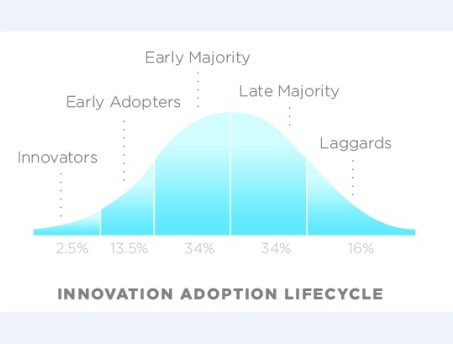Applying OTT Strategy to Innovation Adoption Lifecycle

Over-the-top (OTT) viewing itself may be common, but no two networks approach the concept exactly alike. Some are yet to offer a single program online, while the other end of the spectrum is full of Hulu-esque providers that have never had a numbered channel to turn to. If TV right now isn’t a Wild Wild West of offerings, it’s close.
Different viewers expect different things, and it can’t be easy for the traditional networks to please everyone. For every device-viewer out there, there’s someone else who remembers having to turn the knob on a rotor box.
As crazy as all this sounds, it’s normal. In 1957, Joe Bohlen, George Beal, and Everett Rogers called the changing of systems “the diffusion model.” In 1962, Rogers formulated this model into a bell curve now called the Innovation Adoption Lifecycle. (Image via Wikipedia.) The three researchers may have come up with the concept to explain why grain sales lagged for certain farmers, but it’s since been used to explain why VHS beat Beta, why Apple diehards camp overnight for a new phone, and why your grandmother finally got on Facebook. All new ideas -- be they products, technology, or ways of life -- go through the same societal cycle: You have your innovators, your early adopters, and your early majority. Then the late majority and laggards finally straggle behind.
I think it’s interesting that if you add it up, roughly half of society gets grouped as “late.” Getting a new concept going takes so much work that the 50% of us on the front half of the curve have to be divided into three waves, not just two like the remaining waters.
It isn’t easy to be an innovator. Trust me; I am one. I created TVRunway, a visual search engine that integrates inside existing OTT players via API. Not quite sure what that means? You’re not the only one. That’s because a year ago, the tech didn’t even exist yet. TVRunway and I are still in that innovators category, trying to convince the remaining 97.5%. Sounds daunting, but flip the stats another way, and there’s hope in the fact that it only takes 2.5% of any group to change the world.
Look at Hulu for example. When the platform publicly launched in 2008, I remember watching their commercials but having no idea at the end of them what Hulu did. My friends and I all talked about it. Yes, we agreed, Alec Baldwin was funny, but no, none of us understood what the heck he was advertising or how we were supposed to engage with it.
Fast forward three years and the online streaming of shows and movies had become so common, Netflix flew solo, breaking DVD rental off into Qwikster. The 2.5% had begun to convince the 13.5% and early adoption was well underway.
The smarter way to stay on top of the multichannel video marketplace. Sign up below.
I personally believe we have now come to the precipice for television. Now is the pivotal time where we see the shift from early to late. Now is the window where you decide if your network will be in the first half or in the last.
Right now, the cable industry is understandably concerned about how to stay alive. Last December, Pew Research Center reported that 15% of Americans are cord-cutters. Not shavers, but cutters. The shavers are still there, and they’ve given birth to the cord-nevers: The 9% of Americans who have never had a cable subscription and don’t ever plan to get one. They’re part of that 46% of Americans who tell Pew they don’t watch enough “traditional” television to substantiate paying for cable.
It may not be cable, but these people are still watching something. They’re just the early half of television’s 50/50 innovation point.
Where are you? Are you early, or are you late? It’s easy to say a network should base its OTT strategy off viewership. Which half are they in? It makes sense that The CW Network would have the most mobile-friendly viewer interface in broadcasting today. After all, they do “dare to defy.” But when your branding isn’t quite so clear, when your slogan doesn’t make it easy to be different, where do you fall?
It’s this identity crisis that has prolonged the Wild Wild West of sorts OTT finds itself in now. As a whole, Bohlen, Beal, and Rogers’ research claimed any concept ran through the Innovation Adoption Lifecycle typically reaches full diffusion in 10 years. If we take the birth of Hulu as the birth of the innovators, that means in two years, the OTT adoption curve should be complete.
That means the other half of the world would be OTT-participant by 2018. Are we ready? Or will our industry still be figuring out who we are and what we want to do? Where do you see OTT in two years? Are you riding into the sunset with us, or are you on the laggard end, holding a severed cord?
Terena Bell is CEO of TVRunway, the industry's first OTT commerce platform that doesn't edit, tag or alter the original video in any way.
